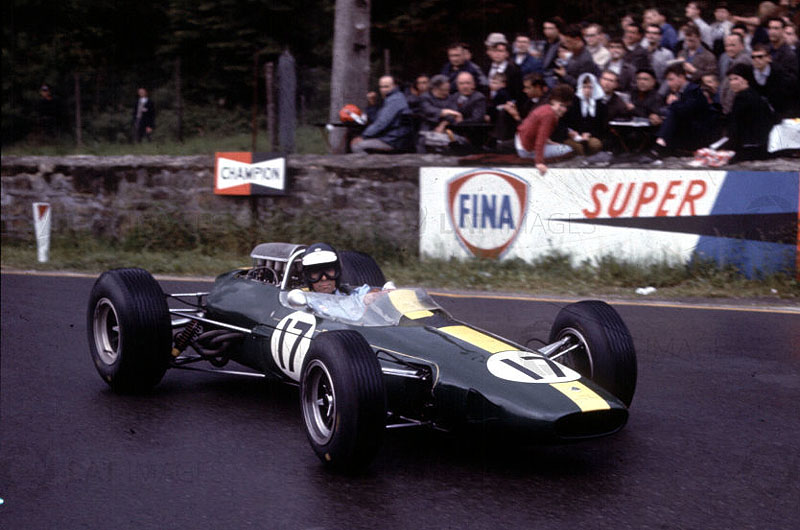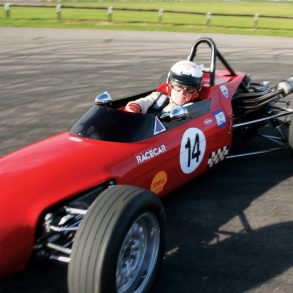Lotus 33
Car: Lotus-Climax 33 / Engine: Coventry Climax FWMV 90º V8 / Maker: Lotus / Bore X Stroke: 67.9 mm x 51.6 mm / Year: 1964 / Capacity: 1,495 cc / 91.2 cu in / Class: Formula 1 / Power: 205 bhp / 153 KW / Wheelbase: 2335 mm (91.9 in) Track: Front: 1396 mm (55 in) Rear:1421 mm (55.9 in) / Weight: 451 kilo / 994 lbs
The Lotus 33 was closely based on the 25, and the specifications of the two cars appear similar but with the advent of wider Dunlop tires mounted on 13in wheels drove a need for new suspension design and a stiffer chassis. The Lotus 33 also had a slightly longer engine bay to accommodate the later versions of the Coventry Climax V8 engine.
Jim Clark gave the Lotus 33 its race debut at the non-championship Aintree 200 race on April 18, 1964. He led but a crashed while lapping a back marker, seriously damaging the only Lotus 33 chassis. This Lotus 33 was straightened out, and Clark took it to its first win at the non-championship Solitude Grand Prix on July 19th.
It was not until the German Grand Prix in August did the Lotus 33 make its debut in a championship event. Unfortunately for Clark it also marked the begining of three straight retirements. Three drivers went to the finale in Mexico City in contention for the World Championship. Graham Hill led on 39 points, John Surtees had 34 and Clark at 30. Hill was soon out of contention for points when he was struck from behind by Lorenzo Bandini, Surtees’ teammate. Clark looked set for the title but with just two laps to go he was struck with engine trouble. Surtees who had worked his way up, to third was waved into second behind Dan Gurney by team-mate Bandini. This was enough for Surtees to take the title from Hill even though Clark had the most wins in the season at three.
For the last year of the 1 1/2-litre formula both the Lotus and Brabham teams had at their disposal a new Coventry Climax 32-Valve V8 with mechanical fuel injection. The FWMV Mk.III and Mk.4 versions of the engine became famous for proving that flatplane crankshaft design is more advantageous for a racing V8 than crossplane, in spite of the engineering theories at the time suggesting otherwise. Flatplane crankshaft became the norm in V8 racing engine designs from the 1970s to the present day. Problems with fuel surge and vaporization were rectified and armed with a more powerful engine and a fully developed chassis, Lotus hoped to reverse the trend of last year.
The 1965 season began with South Africa holding the first race which was dominated by Clark in his Lotus followed by Surtees and Hill. Monaco was next and the race was held without Clark, who was at Indianapolis winning that year’s classic in a Lotus Type 38 powered by an American Ford engine under a partnership with the American giant that would have tremendous consequences for Formula 1 in the near future. The Monaco race was won by Clark’s rival Graham Hill in a BRM. Hill’s victory at Monaco was his third in succession. Clark returned for Spa and won in the wet in front of the year’s sensation, Jackie Stewart. Clark and Stewart repeated their results at the French Grand Prix.The British Grand Prix as well as the Dutch and German fell to Clark’s all-out assault on the record books.
With only the top six races counting Clark claimed a perfect score and his second World Championship. Only when his Lotus suffered mechanical failure or was absent was there any hope for the others, such was his dominance. A broken fuel pump allowed Stewart a win in his maiden season and a engine failure allowed Hill to come through. The last race of the season was held at the Autodrome Magdalena Mixhuca in Mexico City. Always a problem for the teams due to the high altitude of the circuit it proved to be an advantage to Honda as they and Richie Ginther claimed their first victory.
More Lotus Race Cars


















